Plot summary
The story is introduced with the epigraph "Ce grand malheur, de ne pouvoir être seul" — a quote taken from The Characters of Man by Jean de La Bruyère. It translates to This great misfortune, of not being able to be alone. This same quotation is used in Poe's earliest tale, "Metzengerstein". [1]
After an unnamed illness, the unnamed narrator sits in an unnamed coffee shop in London. He is fascinated by the crowd outside the window, and considers how isolated people think they are, despite "the very denseness of the company around". He takes time to categorize the different types of people he sees. As evening falls, the narrator focuses on "a decrepit old man, some sixty-five or seventy years of age", whose face has a peculiar idiosyncrasy, and whose body "was short in stature, very thin, and apparently very feeble" wearing filthy, ragged clothes of a "beautiful texture". The narrator dashes out of the coffee shop to follow the man from afar. The man leads the narrator through bazaars and shops, buying nothing, and into a poorer part of the city, then back into "the heart of the mighty London". This chase lasts through the evening and into the next day. Finally, exhausted, the narrator stands in front of the man, who still does not notice him. The narrator concludes the man is "the type and genius of deep crime" due to his inscrutability and inability to leave the crowds of London. [2]
Analysis
According to the text of the tale, the reason for the narrator's monomaniacal obsession with the man stems from "the absolute idiosyncrasy of [the man's] expression". He is the only person walking down the street the narrator can't categorize. [2] Why the narrator is so haunted by him is not entirely clear, though it is implied that the two men are two sides of the same person, with the old man representing a secret side of the narrator, [3] though the narrator is unable to see this. [4] The old man may be wandering through the crowd in search of a lost friend or to escape the memory of a crime. [5] The possible evil nature of the man is implied by the dagger that is possibly seen under his cloak [4] — whatever crime he has committed condemns him to wander. [1] This lack of disclosure has been compared to similar vague motivations in "The Cask of Amontillado". [6] Poe purposely presents the story as a sort of mystification, inviting readers to surmise the old man's secret themselves. [4]
At the beginning of the tale, the narrator surveys and categorizes the people around him in a similar way as Walt Whitman in "Song of Myself". Poe's narrator, however, lacks Whitman's celebratory spirit. [7] While viewing these people, the narrator is able to ascertain a great deal of information about them based on their appearance and by noting small details. For example, he notices that a man's ear sticks out a small amount, indicating he must be a clerk who stores his pen behind his ear. Poe would later incorporate this ability to observe small details in his character C. Auguste Dupin. [8] All of this is a virtuoso performance of the representation of social typicality; it owes something to Dickens’s Sketches by Boz , but there is also something of the moralizing medieval Vice in its parade of degenerates, of depraved women and of social outcasts. In one sense this is a sideshow, a digression from the main line of the narrative, which is concerned with the crowd only as an abstract force; in another, however, it brings to the fore the sense that it is only through these social clichés that the crowd can be made humanly understandable. [9]
In describing the man, the narrator "describes a set of contradictory characteristics: ‘there arose confusedly and paradoxically within my mind, the ideas of vast mental power, of caution, of penuriousness, of avarice, of coolness, of malice, of blood-thirstiness, of triumph, of merriment, of excessive terror, of intense — of supreme despair’. The man’s dress, too, is contradictory: his linen is dirty but ‘of beautiful texture’, and through a tear in his cloak the narrator glimpses a diamond and a dagger". [9]
“The Man of the Crowd” stands as a transitional work between the haunting Gothic tales of the late 1830s and the ratiocinative fiction of the early forties, possessing obvious qualities of both. [10]
This story is also the beginnings of Poe's detective stories. Walter Benjamin writes, "[The Man of the Crowd] is something like an X-ray of a detective story. It does away with all the drapery that a crime represents. Only the armature remains: the pursuer, the crowd, and an unknown man who manages to walk through London in such a way that he always remains in the middle of the crowd". [11] In agreeing with Benjamin, William Brevda contributes that “Poe splits the human psyche into pursuer and pursued, self and other, ego and id, “detective” and criminal, past and future…” “Poe also echoes Sophocles in his theme of the guilty knowledge that humans run from and simultaneously toward. In the nightmare Poe dreams for us, the ordinary person, the man in the street is at heart a criminal". [12]
The setting of London is one of the few specific details revealed in the tale. By 1840, London was the largest city in the world with a population of 750,000. [13] Poe would have known London from the time he spent there as a boy with his foster family, the Allans, [1] although he may have relied on the writings of Charles Dickens for details of London's streets. [2] In this story and others, Poe associates modern cities with the growth of impersonal crime. [14]

"The Pit and the Pendulum" is a short story by American writer Edgar Allan Poe and first published in 1842 in the literary annual The Gift: A Christmas and New Year's Present for 1843. The story is about the torments endured by a prisoner of the Spanish Inquisition, though Poe skews historical facts. The narrator of the story describes his experience of being tortured. The story is especially effective at inspiring fear in the reader because of its heavy focus on the senses, such as sound, emphasizing its reality, unlike many of Poe's stories which are aided by the supernatural. The traditional elements established in popular horror tales at the time are followed, but critical reception has been mixed. The tale has been adapted to film several times.

"The Murders in the Rue Morgue" is a short story by Edgar Allan Poe published in Graham's Magazine in 1841. It has been described as the first modern detective story; Poe referred to it as one of his "tales of ratiocination".

"The Tell-Tale Heart" is a short story by the American writer Edgar Allan Poe, first published in 1843. It is told by an unnamed narrator who endeavors to convince the reader of his sanity while simultaneously describing a murder he committed. The victim was an old man with a filmy pale blue "vulture-eye", as the narrator calls it. The narrator emphasizes the careful calculation of the murder, attempting the perfect crime, complete with dismembering the body in the bathtub and hiding it under the floorboards. Ultimately, the narrator's actions result in him hearing a thumping sound, which he interprets as the dead man's beating heart.

"The Gold-Bug" is a short story by American writer Edgar Allan Poe published in 1843. The plot follows William Legrand, who becomes fixated on an unusual gold-colored bug he has discovered. His servant Jupiter fears that Legrand is going insane and goes to Legrand's friend, an unnamed narrator, who agrees to visit his old friend. Legrand pulls the other two into an adventure after deciphering a secret message that will lead to a buried treasure.

"The Conqueror Worm" is a poem by Edgar Allan Poe about human mortality and the inevitability of death. It was first published separately in Graham's Magazine in 1843, but quickly became associated with Poe's short story "Ligeia" after Poe added the poem to a revised publication of the story in 1845. In the revised story, the poem is composed by the eponymous Ligeia, and taught to the narrator in the fits of her death throes.

Le ChevalierC. Auguste Dupin is a fictional character created by Edgar Allan Poe. Dupin made his first appearance in Poe's 1841 short story "The Murders in the Rue Morgue", widely considered the first detective fiction story. He reappears in "The Mystery of Marie Rogêt" (1842) and "The Purloined Letter" (1844).

"The Facts in the Case of M. Valdemar" is a short story by the American author Edgar Allan Poe about a mesmerist who puts a man in a suspended hypnotic state at the moment of death. An example of a tale of suspense and horror, it is also to a certain degree a hoax, as it was published without claiming to be fictional, and many at the time of publication (1845) took it to be a factual account. Poe admitted it to be a work of pure fiction in letters to his correspondents.
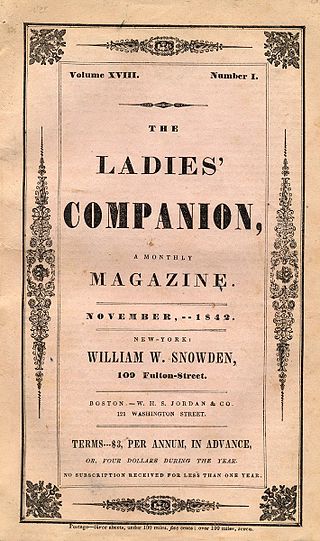
"The Mystery of Marie Rogêt", often subtitled A Sequel to "The Murders in the Rue Morgue", is a short story by American writer Edgar Allan Poe written in 1842. This is the first murder mystery based on the details of a real crime. It first appeared in Snowden's Ladies' Companion in three installments, November and December 1842 and February 1843. Poe referred to it as one of his "tales of ratiocination".
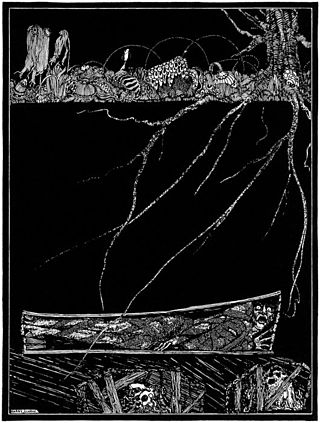
"The Premature Burial" is a horror short story by American writer Edgar Allan Poe, published in 1844 in The Philadelphia Dollar Newspaper. Its main character expresses concern about being buried alive. This fear was common in this period and Poe was taking advantage of the public interest. The story has been adapted to a film.

"Ligeia" is an early short story by American writer Edgar Allan Poe, first published in 1838. The story follows an unnamed narrator and his wife Ligeia, a beautiful and intelligent raven-haired woman. She falls ill, composes "The Conqueror Worm", and quotes lines attributed to Joseph Glanvill shortly before dying.
"Metzengerstein: A Tale in Imitation of the German" is a short story by American writer and poet Edgar Allan Poe, his first to see print. It was first published in the pages of Philadelphia's Saturday Courier magazine, in 1832. The story follows the young Frederick, the last of the Metzengerstein family, who carries on a long-standing feud with the Berlifitzing family. Suspected of causing a fire that kills the Berlifitzing family patriarch, Frederick becomes intrigued with a previously unnoticed and untamed horse. Metzengerstein is punished for his cruelty when his own home catches fire and the horse carries him into the flame. Part of a Latin hexameter by Martin Luther serves as the story's epigraph: Pestis eram vivus—moriens tua mors ero.

"Eleonora" is a short story by American writer Edgar Allan Poe, first published in 1842 in Philadelphia in the literary annual The Gift. It is often regarded as somewhat autobiographical and has a relatively "happy" ending.

Burton's Gentleman's Magazine and American Monthly Review, was a literary publication published in Philadelphia from 1837 to 1840. Its founder was William Evans Burton, an English-born immigrant to the United States who also managed a theatre and was a minor actor. Edgar Allan Poe was an editor and contributor in 1839–40.
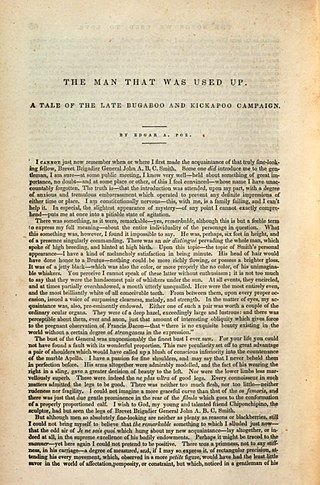
"The Man That Was Used Up", sometimes subtitled "A Tale of the Late Bugaboo and Kickapoo Campaign", is a short story and satire by Edgar Allan Poe. It was first published in August 1839 in Burton's Gentleman's Magazine.

Tales of the Grotesque and Arabesque is a collection of previously published short stories by Edgar Allan Poe, first published in 1840.

"Never Bet the Devil Your Head: A Moral Tale" is a short story by American author Edgar Allan Poe, first published in 1841. The satirical tale pokes fun at the notion that all literature should have a moral and spoofs transcendentalism.
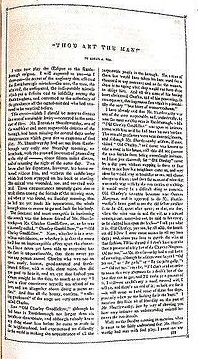
"Thou Art the Man", originally titled "Thou Art the Man!", is a short story by Edgar Allan Poe, first published in 1844. It is an early experiment in detective fiction, like Poe's "The Murders in the Rue Morgue", though it is generally considered an inferior story.
"The Business Man" is a short story by Edgar Allan Poe about a businessman boasting of his accomplishments. It was published in February 1840 in Burton's Gentleman's Magazine. The story questions the concept of a self-made man.
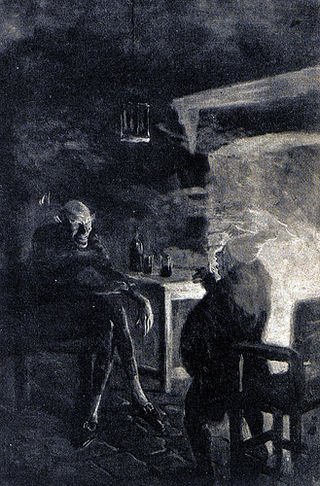
"Bon-Bon" is a comedic short story by Edgar Allan Poe, first published in December 1832 in the Philadelphia Saturday Courier. Originally called "The Bargain Lost", it follows Pierre Bon-Bon, who believes himself a profound philosopher, and his encounter with the Devil. The story's humor is based on the verbal interchange between the two, which satirizes classical philosophers such as Plato and Aristotle. The Devil reveals that he has eaten the souls of many of these philosophers.

The works of American author Edgar Allan Poe include many poems, short stories, and one novel. His fiction spans multiple genres, including horror fiction, adventure, science fiction, and detective fiction, a genre he is credited with inventing. These works are generally considered part of the Dark romanticism movement, a literary reaction to Transcendentalism. Poe's writing reflects his literary theories: he disagreed with didacticism and allegory. Meaning in literature, he said in his criticism, should be an undercurrent just beneath the surface; works whose meanings are too obvious cease to be art. Poe pursued originality in his works, and disliked proverbs. He often included elements of popular pseudosciences such as phrenology and physiognomy. His most recurring themes deal with questions of death, including its physical signs, the effects of decomposition, concerns of premature burial, the reanimation of the dead, and mourning. Though known as a masterly practitioner of Gothic fiction, Poe did not invent the genre; he was following a long-standing popular tradition.



















